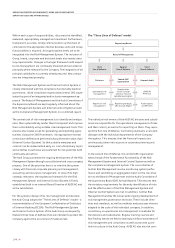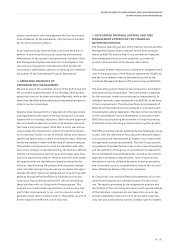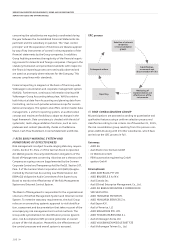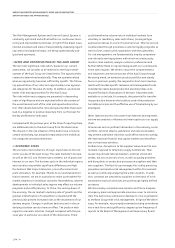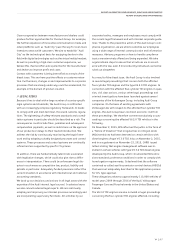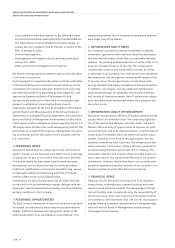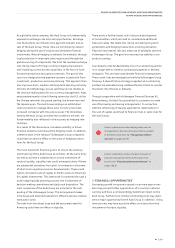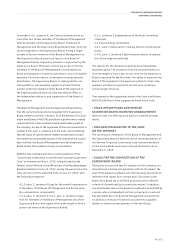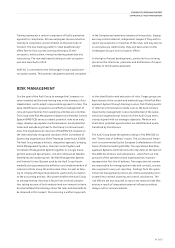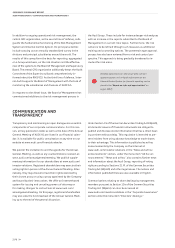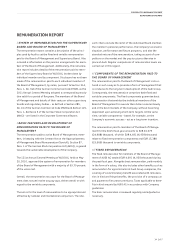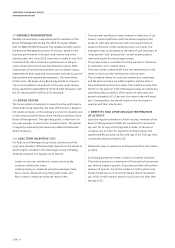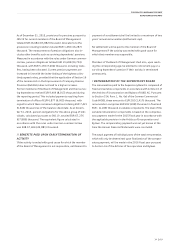Audi 2015 Annual Report Download - page 199
Download and view the complete annual report
Please find page 199 of the 2015 Audi annual report below. You can navigate through the pages in the report by either clicking on the pages listed below, or by using the keyword search tool below to find specific information within the annual report.
REPORT ON EXPECTED DEVELOPMENTS, RISKS AND OPPORTUNITIES
REPORT ON RISKS AND OPPORTUNITIES
>> 199
As a globally active company, the Audi Group is fundamentally
exposed to exchange rate risks and opportunities. Exchange
rate fluctuations can influence the payment streams and as-
sets of the Audi Group. These risks are minimized by natural
hedging and by the use of original and derivative financial
instruments. Natural hedging is achieved, for example, through
local production in important sales regions and through the
global sourcing of components. We limit the residual exchange
rate risk by means of foreign currency hedging transactions
with matching currencies and maturities, in the form of both
forward transactions and options contracts. The goal of this
cover is to hedge planned payment streams in particular from
investment, production and sales planning. This approach then
also improves short, medium and long-term planning certainty.
In terms of methodology, we use cash-flow-at-risk models as
the decision-making basis for our currency management. Risks
exist predominantly in the following currencies: the U.S. dollar,
the Chinese renminbi, the pound sterling, the Korean won and
the Japanese yen. The Audi Group employs an established
control process to manage these risks. Currency risks have
increased compared with the previous year. The derivatives
used by the Audi Group, provided the conditions are met, are
fundamentally also reflected in the accounts as hedging rela-
tionships.
As a result of the diesel issue, increased volatility in future
financial streams could impact the hedging result. In addition,
a deterioration in the rating of Volkswagen Group companies
could have an adverse effect on the costs of hedging transac-
tions for the Audi Group.
The most important financial goal is to ensure the solvency
and financing of the Audi Group at all times. At the same time,
we seek to achieve a suitable return on the investment of
surplus liquidity. Liquidity risks could arise particularly if there
are substantial deviations from plan, for example in the event
of short-term negative economic developments. These could
lead to increased costs of capital or hinder access to financing
for capital investments. This latent risk is countered through a
multi-stage liquidity planning process, the involvement of
decision-making committees and daily cash disposition. The
main companies of the Audi Group are included in the cash
pooling of the Volkswagen Group. This arrangement makes
intra-Group and external transactions efficient and also reduces
transaction costs.
The risks from the diesel issue and the associated need for
financing could have an effect on liquidity.
There exists a further latent risk in the price development
of commodities, which can lead to considerable additional
financial outlay. We tackle this risk by concluding long-term
agreements and hedging transactions involving derivative
financial instruments. We also make use of synergies with the
Volkswagen Group. The goal is to ensure price stability in our
product costings.
Counterparty risks fundamentally occur if a contracting partner
is no longer able to meet its contractual payment or delivery
obligation. This can have considerable financial consequences.
These credit risks are managed centrally by Volkswagen Group
Treasury. A diversification strategy is applied and contracting
partners are evaluated using creditworthiness criteria to counter
the latent risk of losses or defaults.
Through cooperation with Volkswagen Financial Services AG,
Braunschweig, the Audi Group enables its customers to make
use of borrowing and leasing arrangements. In connection
with the refinancing of leasing agreements, deterioration in
the cost of capital could lead to financial risks or sales risks for
the Audi Group.
Further information on the hedging policy and risk
management in the area of financial risks is provided
in the Notes under item 36 “Management of finan-
cial risks” on pages 267 ff.
Further information on the principles and goals of
financial management of the Audi Group can be
found under “Financial performance indicators” on
p
ages 165 ff.
// FINANCIAL OPPORTUNITIES
Increasing growth in economic output in our main export mar-
kets may prompt further appreciation of a country’s national
currency and have a correspondingly beneficial impact on the
Audi Group. Furthermore, falling commodity prices may repre-
sent a major opportunity for the Audi Group. In addition, rising
interest rates may have a positive effect on returns from the
investment of surplus liquidity.



